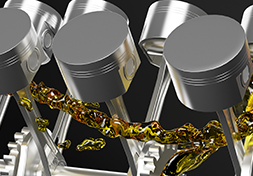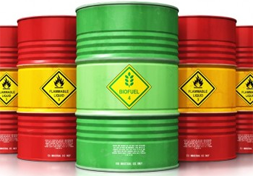After years of accumulation, the Shanghai Research Institute of Sinopec Lubrican...
detailsWith the development of industrial technology, the high speed, high performance, high automation, high efficiency and long life required by modern equipment cannot be satisfied by simply using mineral oil lubricating materials in lubrication. Adding small amounts of other substances to a lubricant can improve its performance and give it new properties. These substances are called additives for lubricating oils.
Adding different additives to oil is the most economical and effective means to improve oil quality. Generally speaking, the variety and quality of lubricating oil often depends on the variety and quality of additives. Therefore, developing the production and use of additives has become an important way to rationally and effectively utilize resources, improve equipment performance and save energy.
Lubricating oil additives can be divided into detergent and dispersant, anti-oxidant and anti-corrosion agent, extreme pressure anti-wear agent, oily agent and friction modifier, antioxidant and metal deactivator, viscosity index improver, rust inhibitor, reducer. Coagulants, anti-foaming agents, etc. are grouped, and the mechanism of action of commonly used lubricating oil additives is introduced below.
1. Detergent and dispersant
Detergents and dispersants include two types of detergents and dispersants. Mainly used for internal combustion engine oil (gasoline oil, diesel oil, railway diesel locomotive oil, two-stroke gasoline engine oil and marine engine oil). Its main function is to keep the interior of the engine clean, so that the generated insoluble substances are in a colloidal suspension state, so as not to further form carbon deposits, paint films or sludge. Specifically, its function can be divided into four aspects: acid neutralization, solubilization, dispersion and washing.
1) Acid neutralization: Detergent dispersants generally have a certain degree of alkalinity, and some are even highly alkaline, which can neutralize the organic and inorganic acids generated by the oxidation of the lubricating oil, preventing their further condensation, thus making the paint film At the same time, it can also prevent the corrosion of engine components by these acidic substances.
2) Solubilization: Detergents and dispersants are all surfactants, which can solubilize solid or liquid substances that cannot be dissolved in oil in the micellar center composed of 5-20 surfactant molecules. During use, it will solubilize oxygenated compounds containing hydroxyl, carbonyl, carboxyl, nitro compounds, moisture, etc. into micelles to form colloids, preventing further oxidation and condensation, and reducing harmful deposits on engine components formation and aggregation.
3) Dispersion: It can absorb the solid small particles such as carbon deposits and paint films that have been formed, making them a colloidal solution state and dispersing in the oil, preventing these substances from further agglomerating into large particles and adhering to the machine parts, or depositing for sludge.
4) Washing function: It can wash off the paint film and carbon deposits that have been adsorbed on the surface of the parts, and disperse them in the oil to keep the engine and metal surfaces clean.
The structure of the detergent and dispersant is basically composed of three groups: lipophilic, polar and hydrophilic. Due to the difference in structure, the performance of the detergent and dispersant is different. Well, the dispersibility of the ashless additive is outstanding.
Typical representatives of detergent dispersants are sulfonates, alkylphenates, salicylates, succinimides, succinates and polymers. The first three are also called ash cleaning dispersants, and the latter three are called ashless cleaning dispersants.
2. Antioxidants
Antioxidants and antioxidants and anticorrosion agents can inhibit the oxidation of oil products, and are mainly used in industrial lubricating oils, internal combustion engines and process oils. Antioxidants can be divided into two types according to their principle of action: 1) chain reaction terminators; 2) peroxide decomposers. Commonly used shielding phenolic and amine compound antioxidants, which belong to chain reaction terminators, can form stable products (ROOH or ROOA) with peroxide groups (ROO.), thereby preventing the oxidation reaction of hydrocarbon compounds in lubricating oil, Such as 2,6 phenol, 4,4 methylene bisphenol, α-naphthylamine, N,N-di-sec-butyl-p-phenylenediamine, etc.
The peroxide decomposer can decompose the peroxide generated in the oxidation reaction of oil products, so that the chain reaction cannot continue to develop and play an antioxidant role; it can generate inorganic complexes during the thermal decomposition process, and form a protective film on the metal surface. It plays an anti-corrosion effect; under extreme pressure conditions, a chemical reaction occurs on the metal surface to form a sulfide film with bearing capacity to play an anti-wear effect, so it is a multi-effect additive. The main varieties of antioxidants and anticorrosion agents are zinc dialkyl dithiophosphate (ZDDP), thiophosphoric alkyl zinc salt, thiophosphoric octyl zinc salt and its series products.
Phenolic and amine antioxidants are mostly used in transformer oil, industrial lubricating oil, turbine oil and hydraulic oil. The dialkyl dithiophosphate zinc salt and other compounds containing sulfur, phosphorus or organic selenium are often used in handicraft lubricating oil, internal combustion engine oil and process oil. However, the lubricating oil containing dithiophosphate is not suitable for the diesel locomotive with silver-plated toggle pins and the top steel sleeve of the connecting rod of the lubricated engine. Machine usage requirements.
3. Oily and extreme pressure antiwear agent
1) Extreme pressure antiwear agent refers to an additive that can form a high melting point chemical reaction film with the metal surface under the boundary lubrication state of high temperature and high pressure to prevent sintering, seizure and scratching. Its function is that the products decomposed under friction and high temperature can react with the metal to generate compounds with lower shear stress and melting point than pure metal, thereby preventing the contact surface from occluding and welding, and effectively protecting the metal surface. Extreme pressure anti-wear agent is mainly used in lubricating oil with extreme pressure requirements such as industrial gear oil, hydraulic oil, guide oil, cutting oil, etc., in order to improve the extreme pressure and anti-wear performance of oil products.
Extreme pressure antiwear agents are generally divided into organic sulfides, phosphides, chlorides, organic metal salts and borate extreme pressure antiwear agents. The main varieties of extreme pressure antiwear agents are: chlorinated paraffin, acid dibutyl phosphite, nitrogenous derivatives of thiophosphoric acid, tricresyl phosphate, sulfided isobutylene, dibenzyl disulfide, lead naphthenate, borate Wait.
2) Any additives that can increase the strength of the lubricating oil film, reduce the friction coefficient, improve the anti-wear ability, and reduce the friction and wear between the moving parts are called oily agents.
An oily agent is a surfactant with a polar group at one end of the molecule and an oil-soluble hydrocarbon group at the other end. Substances containing this polar group have a strong affinity for the metal surface, which can be firmly oriented and adsorbed on the metal surface, forming a protective film similar to a buffer between the metals to prevent direct contact between the metal surfaces , reducing friction and wear.
Oily agents have high interfacial activity, and they produce physical or chemical adsorption on metal surfaces. Physical adsorption is reversible. In the case of low temperature and small load, physical adsorption works; under high temperature and high load, the adsorbent will desorb and lose its effect. In addition to physical adsorption, fatty acid-based oily agents also have chemical adsorption, which can form metal soaps with metal surfaces at lower temperatures to improve wear resistance.
Commonly used oily agents are higher fatty acids (such as stearic acid, palmitic acid, oleic acid, lauric acid, palmitic acid, ricinoleic acid, etc.), fatty acid esters (such as ethyl stearate, butyl oleate, etc.), Fatty acid amine or amide compounds (such as stearic amine, N,N-di(polyethylene glycol) octadecylamine, stearamide, etc.), sulfurized whale oil, sulfurized cottonseed oil, dimer acid, benzotriazole fat Amine salts and acid phosphates, etc. Oil-based agents are mainly used in industrial lubricating oil, hydraulic oil, rail oil, gear oil, etc.
4. Viscosity index improver
Viscosity index improvers, also known as tackifiers or viscosity agents, are second only to cleaning and dispersing agents in production. Viscosity index improvers are oil-soluble chain polymers with molecular weights ranging from tens of thousands to millions.
Viscosity index improvers are dissolved in lubricating oil. At low temperature, they exist in the form of coils, which have little effect on the viscosity of lubricating oil. The increased resistance results in a relatively significant increase in the viscosity of the lubricating oil.
Since the viscosity index improver has different forms and has different effects on the viscosity at different temperatures, it can increase the viscosity and improve the viscosity-temperature performance, so the viscosity index improver is mainly used to improve the viscosity index of lubricating oil, improve the viscosity-temperature performance, increase the viscosity viscosity. Viscosity index improver can be used to prepare thickened oil, so that the prepared oil has excellent viscosity-temperature performance, good low-temperature starting performance, low fuel consumption, and certain anti-wear effect.
Viscosity index improvers are widely used in internal combustion engine oils, mainly in the production of multi-grade gasoline and diesel oils, but also in hydraulic oils and gear oils. Commonly used viscosity index improvers are: polyisobutylene, polymethacrylate, ethylene/propylene copolymer, styrene and diene copolymer and polyethylene n-butyl ether, etc.
Five, pour point depressant
After the temperature of the oil drops to a certain level, it will lose its fluidity and solidify. The function of the pour point depressant is mainly to reduce the freezing point of the oil and ensure that the oil can flow at low temperatures. Oil contains wax. At low temperature, high melting point paraffin hydrocarbons often precipitate in needle-like or flake-like crystals, and are connected with each other into a three-dimensional network structure to form a crystalline framework, which adsorbs and surrounds low-melting point oil, especially water-absorbing oil. Sponge, causing the entire oil to lose its fluidity. The pour point depressant has two functions of adsorption and eutectic. Although the pour point depressant cannot prevent the precipitation of wax crystals, it can change the structure of the wax.
The adsorption of the pour point depressant on the surface of the wax crystal or the formation of a eutectic with it, changes the shape and size of the wax crystal, and prevents the wax crystal grains from connecting to form a three-dimensional network structure, thereby maintaining the fluidity of the oil at low temperatures. PPDs are widely used in various types of lubricating oils, typical representatives are alkyl naphthalenes, polymethacrylates and polyalphaolefins.
6. Anti-rust agent
The role of the rust inhibitor is to form a firm adsorption film on the metal surface to inhibit the contact of oxygen and water, especially water, on the metal surface, so that the metal will not rust. As a rust inhibitor for petroleum additives, it must have sufficient adsorption to metals and solubility to oil, so rust inhibitors are composed of strong polar groups and appropriate lipophilic groups. At present, the widely used and effective ones are as follows: sulfonates (calcium sulfonate, sodium sulfonate and barium sulfonate), carboxylic acids and their salts (dodecenylsuccinic acid, zinc naphthenate) , N-oleoyl sarcosine octadecylamine salt), organic phosphates, imidazoline salts, ester type rust inhibitors (lanolin and lanolin soap, spar-60 or 80, oxidized petroleum oil), heterocyclic Compounds (benzotriazoles), organic amines, etc.
The main water-soluble rust inhibitors are: sodium nitrite, potassium dichromate, trisodium phosphate, diammonium hydrogen phosphate, sodium benzoate, triethanolamine, etc. Rust inhibitors are mainly used in industrial lubricating oils, metal processing cooling lubricating fluids, metal protective oils, etc.
7. Anti-emulsifier
Oil products will be polluted by water during use. For example, mechanical equipment leaks, a large amount of cooling water must be sprayed in order to cool the processed parts, etc., all of which will enter a certain amount of water in the oil, which requires the oil to have a certain water separation. And not emulsified by water into a W/O (water/oil) type emulsion. Because the lubricating oil is emulsified or has poor emulsification resistance, it will lose fluidity (W/O type emulsions will multiply the viscosity of the oil) and loss of lubricity, and also cause metal corrosion and wear. Industrial gear oils, turbine oils, and hydraulic oils (such as oils containing zinc salts) are susceptible to water contamination, so these oils have higher requirements for emulsification resistance.
cause lubricating oilThere are many reasons for poor water separation or emulsification.
1) High viscosity oil will contain some polar components;
2) Various additives are added to industrial lubricating oil, especially detergent and dispersant, rust inhibitor, extreme pressure and anti-wear agent, most of these additives are surfactants, and the anti-emulsification property of the oil should be reduced after adding;
3) The oil is oxidized during use to form easily emulsifiable compounds such as carboxylic acid, which makes the oil anti-emulsification worse.
To deepen the refining depth of the base oil, the selection of suitable additives is a problem that should be considered first, but adding an anti-emulsifier is the main way to improve the anti-emulsification of lubricating oil. The oil/water interfacial tension can be changed after adding an anti-emulsifier to the oil, so as to achieve the purpose of improving the anti-emulsification of the oil. Because the addition of the anti-emulsion agent can eliminate the barriers to the combination of the dispersed phase droplets (that is, eliminate the protective film outside the droplets), so that the droplets can be easily combined together. In addition, the anti-emulsifier can make the emulsion undergo phase inversion, and the W/O type becomes the O/W type to achieve the purpose of water separation. The more commonly used anti-emulsifiers are polyoxypropylene derivatives.
8. Anti-foaming agent
After the lubricating oil base oil is refined, a small amount of polar substances will remain, and as the lubricating oil uses various additives to meet the high performance requirements of various mechanical equipment, foaming will occur in the circulating lubrication system. , not only affects the pumping of lubricating oil, but also destroys the strength and stability of the oil film, causing unnecessary wear accidents, or making the machine unable to operate normally, such as oil failure, air resistance, sintering and other phenomena will continue to occur.
The function of the anti-foaming agent is to inhibit the generation of foam, so as to avoid the formation of stable foam. The most commonly used antifoaming agent is methyl silicone oil antifoaming agent. It is insoluble in oil, and is distributed in oil by colloid mill and other means to make it in a highly dispersed state. Its dosage is generally 1-100 ppm. In addition, there is a non-silicon anti-foaming agent, which is a polyacrylate type polymer ester. Compared with silicone oil, it can effectively improve the air release of oil.
9. Compound Additives
With the improvement of oil quality grade, functional additives are gradually transformed from single agent to compound agent. The performance of the compound additive depends not only on the improvement of the quality of the single agent of the additive, but also through the study of the compound law of the additive to determine the nature of the additive mutual synergy, so as to obtain the compound agent with the best comprehensive performance. The use of compound additives can reduce the difficulty of formula screening, reduce the cost of lubricating oil production and stabilize the production quality of oil products. Now, the position of compound additive in lubricating oil is more and more important.







